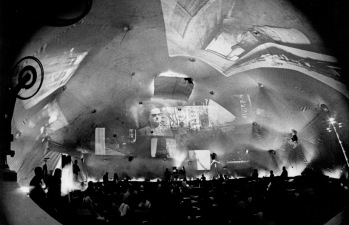[Text fragment from a work in progress]
It is by no accident that the theme of the “Eternal Network” emerged in the ferment of the 1960s and the dawning of the 1970s. It was precisely in this time that the concepts of post-industrialization were first coming into vogue, mobilized by the massive government investment into scientific and technological research during and following the events of World War 2. This collision of science and the demands of war had produced remarkable advancements in computational technology, and also catalyzed rapid evolutions in automated machinery, theories of behavior and cognition, the biological sciences, the studies of servomechanisms and feedback loops, and increased possibilities for large-scale telecommunication systems. Coupled with a relatively high level of economic affluence produced by the quasi-Keynesian capitalism promoted by Roosevelt’s New Deal, Kennedy’s New Frontier, and Johnson’s Great Society, as well as the new political consciousness spawned by the Civil Rights and anti-war movements and the emergent counterculture at large, the effect was a dizzying vision of the immediate possibility of a new world.
Various groups and individuals articulated this sensation through different means. In the early 1960s R. Buckminster Fuller experimented with geodesic domes as means of creating lightweight and easy-to-construct homes, while Marshall McLuhan intoned on the coming of a global village made possible by telecommunication networks. Following McLuhan, the art troupe USCO deployed stroboscopes, film, and tape loops to produce multimedia environments. Other multimedia experiments were taken up by Andy Warhol’s Exploding Plastic Inevitable, which brought together film, dance, music, and visceral lightings with the aim of synthesizing a variety of arts. John Cage attempted to make music from biofeedback, measuring brainwave activity and recording it onto audio tapes for playback. Innovation film and musical techniques were used to simulate the effects of LSD, itself a lab-synthesized hallucinogen. Across the 1960s, technologies were being appropriated to deploy what Andrew Pickering has described as ‘technologies of the self’, “technique[s] for producing states of being that depart from the everyday”.[i]
At the same time, many viewed the technological developments with a little bit more trepidation. Norbert Wiener, whose wartime research into the cybernetics of feedback loops as a means of predictions for anti-aircraft gunners, had written a letter in 1949 to Walter Reuther, the head of the United Auto Workers labor union. He predicted the rise of a flexible machine that, if integrated into the industrial processes, would shatter the power of organized labor as a political force. “I do not wish to contribute,” he wrote, “in any way to selling labor down the river, and I am quite aware that any labor, which is in competition with slave labor, whether the slaves are human or mechanical, must accept the conditions of work of slave labor.”[ii] In 1967, just as the post-industrial society was becoming tangible, Lewis Mumford extended this line of critique into a sweeping condemnation of technology’s central role in life: “With this new ‘megatechnics’ the dominant minority will create a uniform, all-enveloping, super-planetary structure, designed for automatic operation. Instead of functioning actively as an autonomous personality, man will become a passive, purposeless, machine-controlled animal whose proper functions will be strictly limited and controlled for the benefit of de-personalized collective organizations.”[iii]
By the time Mumford was sharping his critical edge, many of these concepts had already passed into the militant sectors of the counterculture through the writings of the Frankfurt School’s Herbert Marcuse. His 1955 work Eros and Civilization had looked to span the chasm between Marxist historical materialism and Freudian psychoanalysis, advancing a peculiar yet provocative reading that saw Freud’s portrayal of civilization operating through the repression of human instinct as the imposed subjective formation required by capitalism itself to anchor labor (and the modes of production by extension) in its exploited state. Technology, he reasoned, held the possibility of liberating labor through the elimination of scarcity: “Technology operates against the repressive utilization of energy in so far that it minimizes the time necessary for the production of the necessities of life, thus saving time for the development of needs beyond the realm of necessity and of necessary waste.”[iv]
In 1964 Marcuse updated his views in perhaps his most famous work, One Dimensional Man. If Eros and Civilization was an exercise in positive thought, this latter work came about through an interrogation of the negative. No longer did advancements in technology hold within it the means to liberate society; subsumed wholly in the mechanics of the military-industrial complex, it had ushered in a mode of production that was “destructive of the free development of human needs and faculties”, calling on the violent irrationality of war as its regulatory order of choice.[v] He continues:
In the face of the totalitarian features of this society, the traditional notion of the “neutrality” of technology can no longer be maintained. Technology as such cannot be isolated from the use to which it is put; the technological society is a system of domination which operates already in the concept and construction of techniques. The way in which a society organizes the life of its members involves an initial choice between historical alternatives which are determined by the inherited level of the material and intellectual culture. The choice itself results from the play of the dominant interests. It anticipates specific modes of transforming and utilizing man and nature and rejects other modes.[vi]
Following the publication of One Dimensional Man, Marcuse was catapulted into the spotlight, serving as an intellectual icon of the burgeoning New Left. While the full scope of his impact on the counterculture might have been exaggerated through the years, he did cultivate close ties with the head of the Berkley Chapter of the Students for a Democratic Society (SDS), and also served as a mentor to Angela Davis, the notable Civil Rights activist and head of the Communist Party USA. By 1968, protestors stormed the streets of Rome bearing signs reading “Marx, Mao, Marcuse!”
It’s not hard to see the affinity between Marcuse’s theories and those of the New Left. He saw, for example, revolutionary possibility emerging not from the proletarian working classes but those who had escaped or were marginalized from ‘advanced industrial society’ – defining revolution as a “Great Refusal”, militant agency would spring from “outcasts and outsiders, the exploited and persecuted of other races and other colors, the unemployed and the unemployable.”[vii] He would soon add the students themselves to this growing list, whose declarations of militancy had begun circulating through the several years prior to One Dimensional Man. The SDS’s Port Huron Statement of 1962 was exemplary in this regard, drawing attention to America’s stark racial divisions, the exclusion from equitable ways of life, and the widening girth of the military-industrial complex. Like Marcuse after them, they honed in on the relationship between technological advancement and these heightened forms of domination. The Keynesian welfare state, given different names by each administration from the New Deal on, was merely “a more reformed, more human capitalism, functioning at three-fourths capacity while one-third of America and two-thirds of the world goes needy, domination of politics and the economy by fantastically rich elites, accommodation and limited effectiveness by the labor movement, hard-core poverty and unemployment, automation confirming the dark ascension of machine over man instead of shared abundance, technological change being introduced into the economy by the criteria of profitability..”[viii] If left unacknowledged and “without new vision, the failure to achieve our potentialities will spell the inability of our society to endure in a world of obvious, crying needs and rapid change.”
The American and European countercultures would not lack in vision. It would come in innumerable forms – from the aforementioned “technologies of the self” to the commune movement to the rise Mao-influenced Third Worldism, each striving towards an autonomy in action, an experience of life, and a fundamental understanding of what “democracy” entailed. The SDS’s fight against technocracy led to a shut-down and teach-ins at MIT, the hotbed of much of the wartime technological research, and sit-ins at Princeton’s Institute for Defense Analysis, an engineering think-tank affiliated with the US Department of Defense.[ix] In the end, however, vision was not enough. By the 1970s military-led innovation entered the market at large and began fundamentally reworking the modes of production on a global scale, formally tipping the scales against labor power. Marcuse had written in Eros Civilization that “civilization has to defend itself against the specter of a world which could be free”[x] – the flexible machine feared by Wiener has come to pass, with no lessening of scarcity or the freeing up of time from labor.
[i] Andrew Pickering The Cybernetic Brain pg. 13
[ii] https://libcom.org/history/father-cybernetics-norbert-wieners-letter-uaw-president-walter-reuther
[iii] Technics and Human Development pg.
[iv] Eros and Civilization, pg. 93
[v] One Dimensional Man pg. 7
[vi] Ibid, pg. 11
[vii] Ibid
[viii] http://coursesa.matrix.msu.edu/~hst306/documents/huron.html
[ix] See Engineers for Change, pg. 108-111
[x] Eros and Civilization pg. 93




Pingback: Cybersocialism by Paul Cockshott | Deterritorial Investigations Unit | Social Network Unionism
Reblogged this on synthetic zero.
Reblogged this on Social Network Unionism.